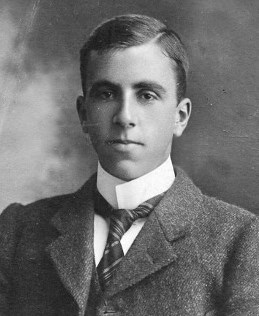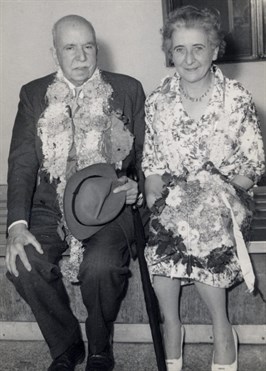Sir Harold Gillies
Kt, CBE, FRCS
Born 17th June 1882, Dunedin, New Zealand
Died 10th September 1960, London, UK.
 Early Life
Early Life
Harold Delf Gillies was born in Dunedin, New Zealand on 17 June 1882, but he came to England to be educated at a preparatory school near Rugby. After this, he returned to Wanganui College, in New Zealand, where he captained the first cricket eleven. Then in 1901 he returned to England once more after winning a place at Gonville and Caius College, Cambridge to study medicine. Having qualified in 1906 following clinical studies at St Bartholomew’s Hospital, London he become a Fellow of the Royal College of Surgeons of England four years later.
In a childhood accident, he had fractured his elbow, which remained stiff ever after. Despite this, he overcame the handicap and managed not only to row for Cambridge in the 1904 Boat Race but also to play golf for England against Scotland, and win the Royal St George Grand Challenge Cup at Sandwich in 1913. Noted as the best house surgeon at St Bartholomew’s Hospital in his time, he decided that ear, nose and throat surgery would be his career. Had it not been for the First World War, he would probably have remained in that specialty, and plastic surgery in the UK may have taken a very different course.
Contributions to Plastic Surgery
First President BAPS 1947
Knighted 1930
CBE 1920
First Multidisciplinary Team-based dedicated plastic surgery unit in the world - Queen Mary’s Hospital, Sidcup, UK
Co-Developer of the tube pedicle flap (Along with Filatov)
First Male to Female transgender surgery
Author: Plastic Surgery of the Face
The First World War
As a junior Captain in the Royal Army Medical Corps, Gillies was posted to France as a general surgeon. Once there, he realised that large numbers soldiers engaged in trench warfare were surviving devastating facial injuries. He successfully lobbied the army chief surgeon, Arbuthnot Lane, to create a special ward at the Cambridge Military Hospital, Aldershot, to provide a unit dedicated to treating these injuries.
When this proved inadequate to cope with the influx of injuries sent there, Gillies negotiated the building of a specialist single-specialty unit called Queen Mary’s Hospital at Sidcup, Kent. Along with surgeons, dentists and support staff from the UK and its Commonwealth Dominions he became the UK’s first dedicated “Plastic Surgeon” and led the development of a multidisciplinary unit dedicated to the specialty. With this approach together with the pioneering of numerous plastic surgical and allied techniques, particularly in anaesthesia, they treated over 5000 patients. The patients usually required multiple operations, over lengthy periods of time. It was during this period at Sidcup that Gillies discovered the utility of a new tissue transfer technique which became known as the “tube pedicle flap”. Whether he invented it is still a matter of some debate. However, he used this to transform reconstructive surgery whilst addressing the simultaneous challenge of rehabilitating men facing lives as social outcasts because of severe disfigurement.
To read more about Sir Harold Gillies visit "Everything Gillies" in the Sidcup Gallery.
The Inter-war years
Gillies military service ended in 1919, but he continued to work at The Queen's for several years. Gillies produced a landmark textbook, “Plastic Surgery of the Face”, published in 1920 based upon many of the techniques pioneered at Sidcup. As the rush of wartime injuries subsided, Gillies thought there would be little demand for “plastic” procedures. He was offered beds and sessions at St Bartholomew’s in London. Slowly his in-hospital and private practice increased to the extent that he needed help. He therefore enlisted and trained first Rainsford Mowlem and later Archibald McIndoe to assist him. By the mid-1930s there remained only four recognised plastic surgeons in England – Gillies, McIndoe, Mowlem and Thomas Kilner, his Sidcup colleague.
Second World War
The threat of another war saw Gillies appointed to develop a national plan for the management of facial and other serious injuries, particularly burns with another Sidcup colleague, dentally trained William Kelsey Fry. At the outset of the Second World War he placed McIndoe in charge of Royal Air Force casualties at East Grinstead while establishing his own hospital at Rooksdown, Basingstoke. Mowlem’s Unit was set up in St. Albans and Kilner’s in Roehampton. He also toured the country finding sites for other units, and at Basingstoke trained numerous surgeons both for front-line service in the rapidly expanding specialty and to staff the newly established units in cities around the UK.
Later life
 At the end of the Second World War Gillies returned to civilian practice and despite advancing years continued to treat patients up until the day of his death in 1960. He was particularly keen to assist the specialty’s development in India, where he went twice on extended tours to teach and lecture. He was instrumental in the foundation of BAPS, becoming its first President. He wrote a second textbook, “Principles and Art of Plastic Surgery” in collaboration with one of his American trainees at Rooksdown, Ralph Millard, later a celebrated cleft palate surgeon. In it they outlined the whole scope of the specialty from facial to genital surgery.
At the end of the Second World War Gillies returned to civilian practice and despite advancing years continued to treat patients up until the day of his death in 1960. He was particularly keen to assist the specialty’s development in India, where he went twice on extended tours to teach and lecture. He was instrumental in the foundation of BAPS, becoming its first President. He wrote a second textbook, “Principles and Art of Plastic Surgery” in collaboration with one of his American trainees at Rooksdown, Ralph Millard, later a celebrated cleft palate surgeon. In it they outlined the whole scope of the specialty from facial to genital surgery.
A meticulous surgeon, Gillies was prepared to cross surgical boundaries and embark upon the unexpected and even frowned-upon, performing the first female to male transgender procedure beginning in 1946. A true all-rounder, he enjoyed fishing, was a competent landscape artist (but avoided painting portraits) and to the irritation of some, was an inveterate practical joker. The instruments he designed, and his surgical principles, still hold good and are used today
To read more about Sir Harold Gillies visit "Everything Gillies" in the Sidcup Gallery.